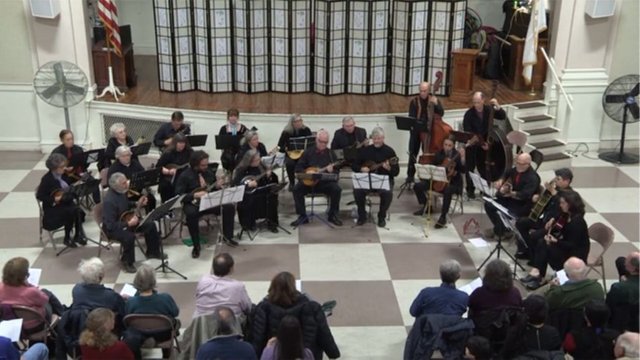
The mandolin first appeared in 15th-century Naples, Italy, as an adaptation of the lute. It was similar to various other string instruments across the globe, including the traditional Russian balalaika, a roundback version from Japan, the Greek bouzouki, the Puerto Rican cuatro, the Brazilian bandolim, and the popular dambura of the Arab world.
Mandolins and similar instruments were brought in to the United States by immigrants from many countries, and were used primarily to play traditional folk and classical music. In 1880, a group of musicians known as the Estudiantina Figaro, or, the “Spanish Students.” landed in New York City. Interestingly enough, they did not play mandolins but Bandurrias, which are small, double-strung instruments from Spain which resemble the mandolin. Playing to wildly enthusiastic audiences in New York and Boston, the students spawned several groups who imitated their musical style and colorful costumes. Many of the players in these new musical ensembles were immigrants who had brought mandolins from their native Italy. These musicians helped to generate enormous public interest in an instrument which previously was relatively unknown in the United States.
From about 1890 to 1925, companies such as Gibson and Martin employed salesmen who traveled across the United States, selling instruments of the mandolin family. The salesmen quickly found that they could generate more sales by establishing mandolin orchestras in the towns they visited. The mandolin was inexpensive enough that working-class people could afford it, and many of the orchestras were formed around community groups such as social clubs, religious organizations, women’s groups, and unions, and playing in the local mandolin orchestra soon became “all the rage”. Groups formed in this period from New York, Baltimore, and Milwaukee still survive to this day.
The mandolin is experiencing a resurgence of popularity in all types of music: bluegrass, country, folk, rock, ethnic, jazz, and classical. This versatility, accessibility, and relative easy learning curve make it the perfect instrument for introducing people to the world of music. The mandolin family is the fretted equivalent (played with a plectrum) of the violin family in tuning and size: mandolin=violin, mandola=viola, mandocello=cello, mandobass=upright bass. Anyone who can play an instrument of the violin family can play its equivalent in the mandolin family. Likewise, anyone who is interested in learning a traditional instrument might find it easier to learn the mandolin first, since the skills learned can translate easily to many folk instruments.
Since the instrument has roots in almost every culture, musicians playing the modern mandolin help to preserve rich musical traditions that might otherwise be lost in today’s increasingly homogenized musical landscape.
The Springfield Mandolin Orchestra is always looking for new members. If you play mandolin, or any other instrument in the mandolin family, and can read music, you are welcome to join. There is no cost to be part of the orchestra, just the ability to commit to the first and third Saturday of each month for rehearsal. Please contact us through the website (www.mandolinorchestra.org) for more information on joining the mandolin orchestra or for taking lessons in mandolin or violin.
Hi! I am a robot. I just upvoted you! I found similar content that readers might be interested in:
http://www.pittsburghmandolinsociety.org/history-of-mandolin
Downvoting a post can decrease pending rewards and make it less visible. Common reasons:
Submit